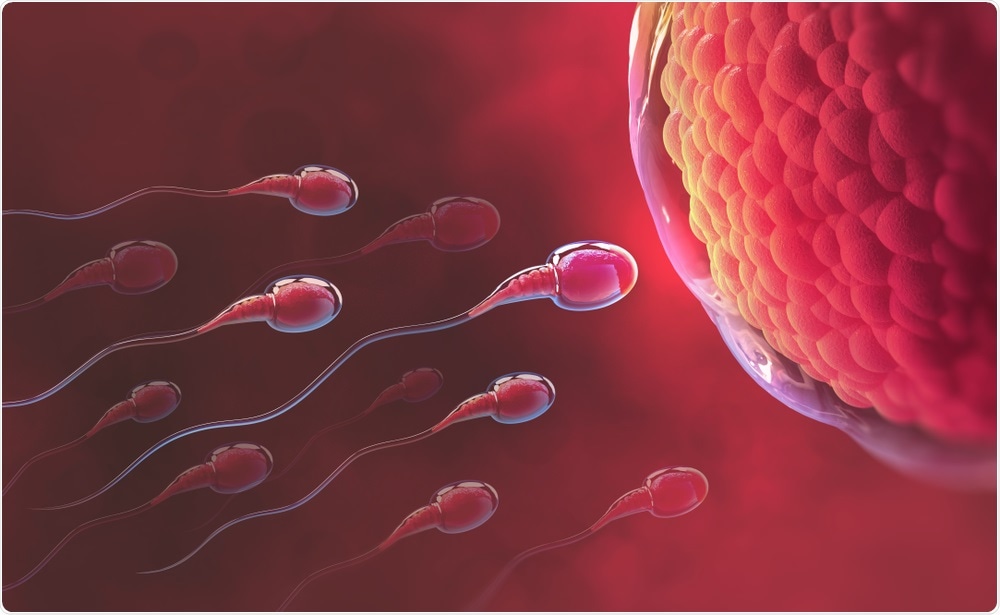An international team of researchers has uncovered valuable insights on the underlying mechanisms involved in the process of sperm release from the oviduct.

Image Credit: Yurchanka Siarhei/Shutterstock.com
In a paper published in the journal, Molecular and Cellular Endocrinology, the researchers explain how they measured changes derived by progesterone-induced release on sperm cells to reveal that progesterone had the impact of increasing the number of binder of sperm proteins, increasing the membrane fluidity of the sperm, and modifying the lipidomic and proteomic profiles of the sperm.
The team also found multiple proteins and lipids that they suggest could be used as biomarkers of sperm fertility.
Mechanisms underlying sperm release have remained unclear
The exact mechanism underlying the detachment of sperm from the oviductal epithelium has eluded scientists. Gaining insights into how the process works would be invaluable to deepening our knowledge of how sperm becomes available to fertilize the oocyte, which would lead to better treatments of fertility.
Previous studies have demonstrated that progesterone (P4), the ovarian steroid, may potentially be responsible for the release of sperm in other species, such as birds and pigs.
Following insemination, it has been observed that sperm form a “functional sperm reservoir”
by binding to the luminal epithelial cells in the oviduct before they are released to the ovum. It is believed that during this stage, which can last between days and hours, the interplay between the oviductal epithelial cells (OECs) and sperm is vital to the process of sperm selection and its release from the reservoir.
However, the mechanisms of how this process is governed had remained unclear.
Therefore, the scientists involved in the current study planned to overcome this gap in knowledge by designing an experiment to uncover the mechanisms implicated in the release of sperm from the reservoir.
In uncovering this information, scientists will have valuable insights related to fertility that may lead to the discovery of biomarkers of male fertility impact on future treatments for it.
Investigating key changes initiated by progesterone release
The research investigated sperm binding activities with bovine oviductal epithelial cells (BOECs). The team used a combination of methods, including Western-Blot, confocal microscopy and Intact Cell MALDI-TOF-Mass Spectrometry to observe and measure key changes initiated by P4 release on the bovine sperm cells.
Previous research has highlighted the role of three distinct proteins, known as a binder of sperm proteins (BSPs), on the action of sperm binding to OECs.
It has been found that BSPs are essential in the processes of sperm membrane stabilization and the prevention of premature capacitation along the female genital tract.
Studies have revealed that the removal of BSPs from the surface of the sperm is likely to be the first step in inducing membrane fluidity, sperm capacitation, and acrosome reaction.
Therefore, researchers first evaluated the role of BSPs on sperm-BOECs binding by measuring the level of BSPs on spermatozoa bound to BOECs before and after P4 was released. Also, changes in membrane fluidity were measured, along with changes in sperm proteins and lipids induced by P4.
The results showed that in comparison with controls, BOEC-P4 spz in the abundance of specific BSPs was decreased.
This hints that the changes brought about by the P4-induced release on sperm cells are likely to be on the underlying mechanism for the detachment of sperm from the oviductal epithelial cells. Also, the results found numerous specific membrane lipids and proteins to be in significantly different levels in BOEC-P4 spz compared with controls.
Future research
The team managed to demonstrate that progesterone initiates the release of sperm with a significantly reduced number of BSPs on the cell surface while demonstrating an increase in membrane fluidity, two factors linked with capacitation.
Also, it was shown that the phospholipid and protein composition of these released sperm cells were significantly different from the controls. The research has provided strong evidence to support the hypothesis that progesterone is vital to activating the pathways leading to the selection of a responsive sperm subpopulation.
These findings are likely to inform future research into fertility treatments.
Journal references:
Hunter, R. (2011). Components of oviduct physiology in eutherian mammals. Biological Reviews, 87(1), pp.244-255. https://onlinelibrary.wiley.com/doi/abs/10.1111/j.1469-185X.2011.00196.x
Ramal-Sanchez, M., Bernabo, N., Tsikis, G., Blache, M., Labas, V., Druart, X., Mermillod, P. and Saint-Dizier, M. (2020). Progesterone induces sperm release from oviductal epithelial cells by modifying sperm proteomics, lipidomics and membrane fluidity. Molecular and Cellular Endocrinology, 504, p.110723. https://www.sciencedirect.com/science/article/pii/S030372072030023X#!
Tienthai, P. (2015). The porcine sperm reservoir in relation to the function of hyaluronan. Journal of Reproduction and Development, 61(4), pp.245-250. https://www.jstage.jst.go.jp/article/jrd/61/4/61_2015-006/_article